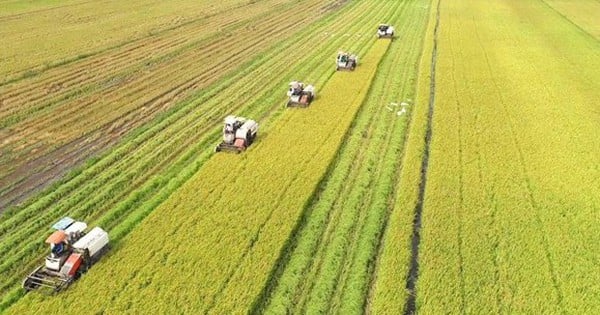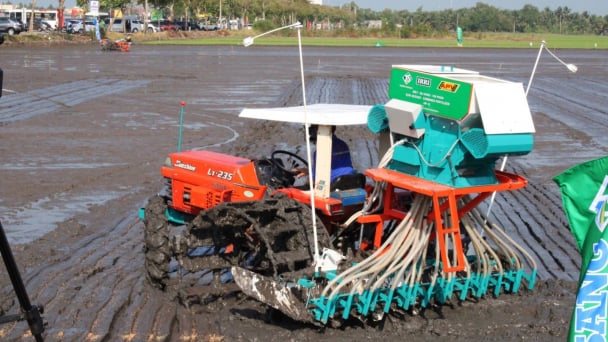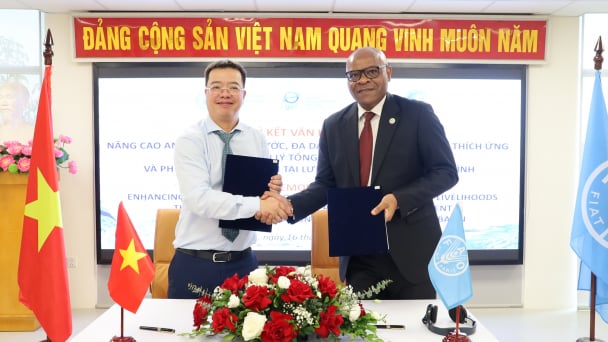May 21, 2025 | 04:56 GMT +7
May 21, 2025 | 04:56 GMT +7
Hotline: 0913.378.918
May 21, 2025 | 04:56 GMT +7
Hotline: 0913.378.918
In recent years, the provincial government of Thai Binh has issued numerous directives and policies to support and encourage the accumulation and concentration of land, thereby creating favorable conditions for the adoption of mechanization, particularly in rice transplant.

Mr. Dang Ngoc Tan, General Secretary of Dai Dien Thai Binh Club shared about problems in land accumulation and concentration. Photo: Trung Quan.
Nguyen Ngoc Tan, general secretary of Dai Dien Thai Binh Club (Thai Binh Big Paddy Club), stated that land accumulation and concentration, along with the introduction of mechanization into rice production, is an unavoidable trend as the agricultural labor force continues to dwindle as a result of the industrial-to-services shift. In addition, only by the accumulation of land can the capacity of machinery be maximized. In turn, production costs are decreased and profits are increased.
According to Tan, the accumulation of land would help form large paddy, facilitate management, planning paddy and irrigation works inferior transportation system, allocate crop frame, eliminate incohesive production of rice varieties, accelerate the use of high-quality rice varieties on production, and move toward the establishment of a rice brand reaching the local and international markets.
When the area is large enough for transplanting, big paddy owners will not hesitate to invest in more machinery to support their operations. Currently, more than half of the Club's 400 members have at least two transplanters for each transplanting area.

Thai Binh Dai Dien Club in a meeting with ThaiBinh Seed discussed the direction of cooperation and development of production links. Photo: TL.
In addition, once the big paddy is completed being transplanted, its area can be expanded to serve the nearby households. Consequently, each large paddy is a large-scale demonstration model, a communication object, and the most compelling evidence to gradually alter people's perception of the method of rice transplanting by machine, using tray plating.
Mr. Dang Ngoc Tan stated that despite the great benefits of land concentration and accumulation, which create the conditions for fast mechanization implementation, this work still faces many obstacles, inadequacies, and a lack of sustainability. Particularly, the greatest obstacle is the dread of losing land among households that own fields but no longer need to produce, which makes it difficult to establish long-term cooperative relationships and encourages large farmers to invest in production promotion with confidence.
Currently, the majority of agreements between large producers and land-leasing households are verbal and not backed by lease contracts or documents witnessed by local officials. Consequently, there has been a case in which a large paddy invested a significant amount of money to collect fields, develop land, purchase machinery, and operate 1-2 crops, and then people demanded the return of the fields.
This created a "dilemma" for the large producers, many of whom had to cover extremely significant losses. More hazardous are the fields with the policy of organic farming, the large paddy that has worked hard to renovate within 3-4 years has to give up midway because when the lessor wants to get it back.

Many difficulties and obstacles in land accumulation and concentration are hindering the introduction of gender into production. Photo: Hoang Anh.
In other instances, big paddy may rent land and want to take advantage of favorable locations for improvement to form a tray plating production yard (the plating yard must have a special design, such as high, fast drainage, a source of water for irrigation, etc.) house to care for and protect...), but regulations prohibit changing the land's status. Although the large producers pledge to return the land to its original state upon request, it is still challenging to do so.
Currently, each large paddy produces an average of 200 tons of rice per crop. Concurrently, the supply is excessively high, whereas the consumption under the affiliate contract is negligible, resulting in primarily market-driven sales. Therefore, the large fields could not utilize all of the rice in a couple of days; the need for drying houses and storage is imperative, but the land fund is limited. This is also why large producers are hesitant to invest in mechanization to expand their acreage: the more they grow, the greater the risks and losses they incur.

The introduction of mechanization into rice cultivation still faces many obstacles due to the fragmented production scale. Photo: Trung Quan.
According to Mr. Mai Thanh Giang, Director of Thai Binh Plant Protection and Cultivation Sub-Department, the People's Council of Thai Binh province issued Resolution No. 29/2021/NQ-HDND on the mechanism, policies to support accumulation and concentration of land, purchase of transplanters and drying equipment systems for agricultural production in the province from 2021 to 2025 on December 10, 2021.
After the Resolution's enactment, the movement to acquire and concentrate land for large-scale production investment by businesses, households, and individuals grew in scope.
Within two years, land accumulation and concentration increased significantly (by more than 48 percent compared to the period preceding 2021). Despite this, the accumulation and concentration of common land is still less than 5ha/region (there are approximately 2,000 organizations and individuals with a total area of over 8,000ha). More than 1,300 hectares are owned by 344 organizations and individuals with areas ranging from 5 to less than 10 hectares. There are approximately 106 organizations and individuals with a total area of approximately 672 hectares in areas between 10 and 20 hectares. There are approximately 27 organizations and individuals with a total area of approximately 339 hectares in areas larger than 20 hectares.

The establishment of plating trays is facing many difficulties due to limited land or not being able to change the current status of the land. Photo: Hoang Anh.
Specifically, on March 22, 2023, the People's Committee of Thai Binh Province issued a decision to establish a working group to devise mechanisms and policies to concentrate land for agricultural economic development.
With the participation of numerous departments such as Departments of Planning and Investment, Agriculture and Rural Development, Natural Resources, and Environment, Finance, etc., the working group is responsible for conducting field surveys, gathering, and statistics on accumulated land and land concentration; grasping difficulties, problems, and recommendations from localities, businesses, cooperatives, and large paddy households in order to propose solutions; and advising on the construction of mechanisms.
Based on the findings and recommendations of the Working Group, the People's Council of Thai Binh Province continued to issue a resolution on mechanisms and policies to support the accumulation and concentration of land for agricultural economic development in Thai Binh Province through 2028 on July 12, 2023.
In order to create a synchronization to promote the process of land accumulation and concentration, the resolution provides funding support for the implementation of propaganda and mobilization of people to accumulate and concentrate land for the People's Committees of communes and village establishments; policies to support people with land use rights; and assistance for organizations, households, and individuals.
Translated by Linh Linh

(VAN) In 2024, over 295 million people across 53 countries and territories faced acute hunger—an increase of almost 14 million people compared to 2023, while the number of people facing catastrophic levels of hunger reached a record high.

(VAN) World Environment Day 2025 (June 5) carries the theme 'Beat Plastic Pollution' continuing to emphasize the global urgency of addressing the plastic waste crisis.

(VAN) This was the assessment shared by experts at the workshop titled 'Assessing the Role and Potential of Low-Emission Rice Production Systems in Vietnam,' held on the morning of May 19.

(VAN) Cai Rong Port is the fisheries control center of Quang Ninh, helping to monitor fishing vessels, combat IUU fishing, and remove the EC's 'yellow card'.

(VAN) The German Agricultural Society (DLG) explores the possibility of establishing a mechanization service center in Vietnam’s Mekong Delta to support farmers in accessing and utilizing advanced machinery.

(VAN) On May 16, the Department of Water Resources Management, in collaboration with the Food and Agriculture Organization of the United Nations (FAO), held a signing ceremony for the GEF-8 project document.

(VAN) Food safety, mechanization, vocational training, and market opening are key areas of cooperation expected between the Vietnamese Government and the Federal Republic of Germany.